Watch CBS News
Be the first to know
Get browser notifications for breaking news, live events, and exclusive reporting.
Watch CBS News
Be the first to know
Get browser notifications for breaking news, live events, and exclusive reporting.
Colorful paintings of daily life in ancient Egypt have been discovered in a tomb dating back more than 4,300 years.
The tomb, known as a mastaba, was found in the pyramid necropolis of Dahshur, about 25 miles south of Cairo, during a recent Egyptian-German archaeological mission.
Dahshur is the southernmost of the great pyramid necropolises of the Old Kingdom in the vicinity of the ancient capital of Memphis. The main attractions there are two large pyramids of King Sneferu: the so-called Bent Pyramid and the Red Pyramid.
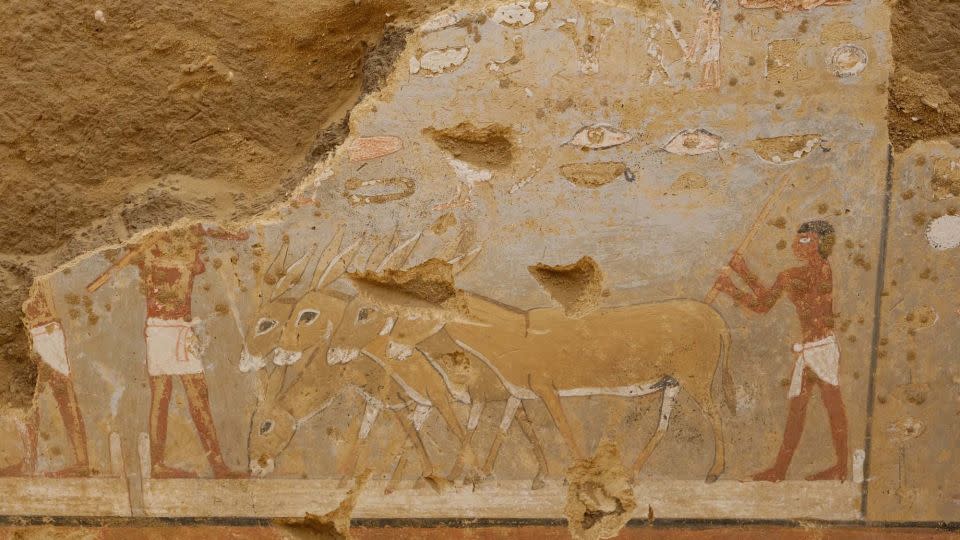
Made from unfired mud brick, the rectangular mastaba measures about 26 feet by 39 feet (8 meters by 12 meters) and features seven burial shafts, as well as another shaft for ceramic bowls and other items used in burial rituals.
According to inscriptions on a massive limestone false door, the tomb belonged to a man named Seneb-nebef, who served in the administration of the residents of the palace district, as well as his wife, Idut.
The shape of the mastaba, together with the inscriptions, images and ceramics found inside, suggest it dates from the end of the 5th or the beginning of the 6th dynasty -approximately 2,300 BCE.

Stephan Seidlmayer, former director of the German Archaeological Institute in Berlin, led the expedition.
He told CNN in an email: “The corridor and the cult chamber were decorated with subtle paintings on mud plaster – a rarity in the necropolis of Dahshur. Despite extensive destruction, numerous images have been preserved. They show pictures of the tomb owner and his wife in front of the offering table, scenes from daily life – donkeys on the threshing floor, ships on the Nile, a market place – and servants who bring gifts for the mortuary cult.
“In their elegant forms and perfect execution, the pictures offer valid evidence of the artistic milieu of the capital region of the developed Old Kingdom.”
According to a statement from the Egyptian Ministry of Tourism and Antiquities, inscriptions revealed that the owner of the tomb “held several positions in the royal palace in the administration of tenants,” while his wife “held the titles of Priestess of Hathor and Lady of the Sycamore.”
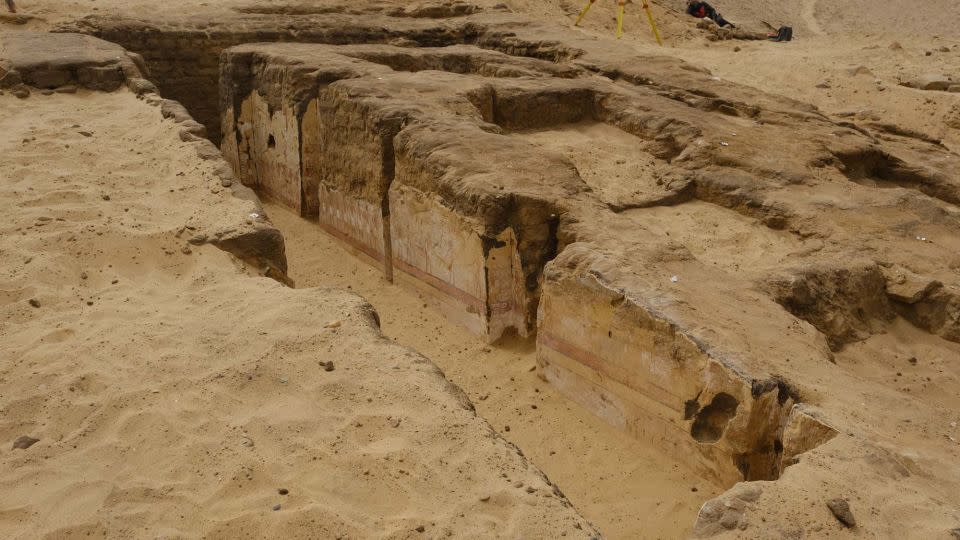
The German Archaeological Institute Cairo has been excavating at Dahshur since 1976. The initial stages focused on the pyramids of King Sneferu from the Old Kingdom and King Amenemhat III from the Middle Kingdom.
More recent excavations have, however, centered on the tombs of great statesmen, priests and administrators from same eras.
Seidlmayer and his team will continue to excavate the site “in an attempt to search for more secrets of this area,” the Egyptian Ministry of Tourism and Antiquities said in its statement. It added: “Cleaning and documentation work will be carried out on the tomb and its inscriptions during the coming period.”
For more CNN news and newsletters create an account at CNN.com
An AFP photographer captured rare shots showing everyday life in North Korea.
Pedro Pardo accessed a remote part of the border in China’s Jilin province to get the photos.
`The images show a bleak picture of life in the completely isolated nation.
An AFP photographer captured rare images showing daily life in North Korea.
To get the photos, Pedro Pardo accessed a remote part of North Korea’s border with China in the latter’s Jilin province.
The images Pardo took between February 26 and March 1 offer a bleak yet fascinating look at life in a country shrouded in secrecy.
North Korea was founded in 1948 under Kim Il-sung as the Democratic People’s Republic of Korea (DPRK), inspired by strict Marxist-Leninist principles.
Its population of roughly 26 million people lives largely in isolation from the rest of the world in the austere communist state, barred from going abroad without permission from the government and subjected to state-run media that blare propaganda praising the nation and its supreme leader, Kim Jong Un.
North Korea’s self-imposed isolation is largely due to its guiding principle of “juche,” or “self-reliance” — the idea that it should be able to function completely independently and remain separate from the rest of the world.
In practice, this has achieved little other than to stifle the country’s economy and trade, and many of its citizens face high poverty levels and severe food shortages. The CIA says North Korea “remains one of the World’s most isolated and one of Asia’s poorest.”
Since the 1950s, it is estimated that around 31,000 North Koreans have sought to escape and defected to South Korea, The Guardian reported in January.
That number surged last year amid what the unification ministry in Seoul called “worsening conditions in North Korea.”
Pardo’s photos present a unique look into those conditions and life in one of the world’s last communist states.
North Korean soldiers working on the border.
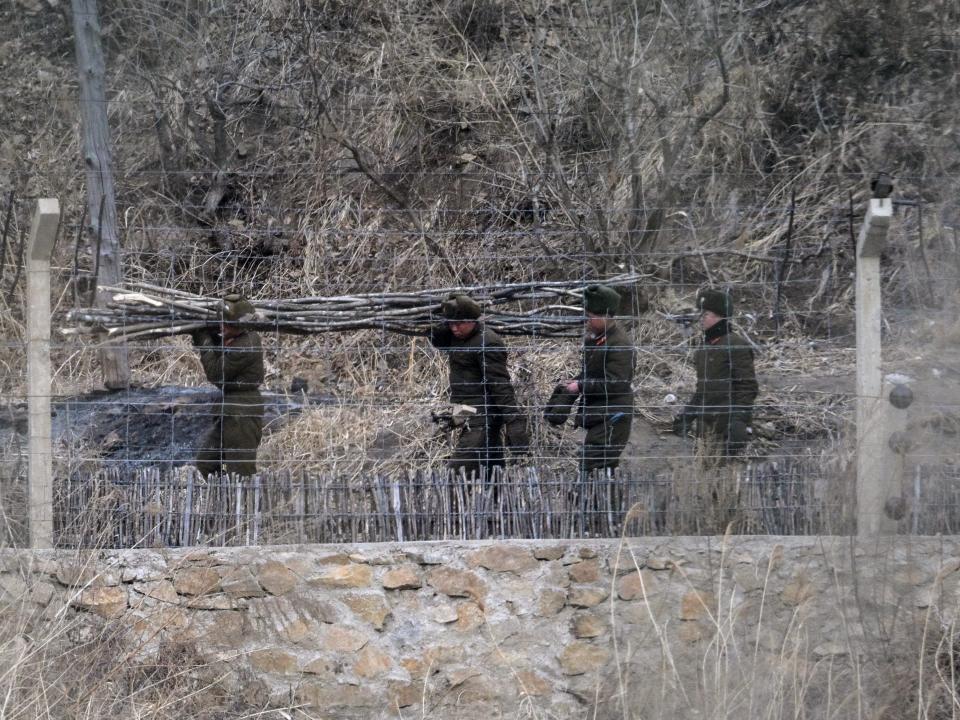
The North Korean city of Hyesan.
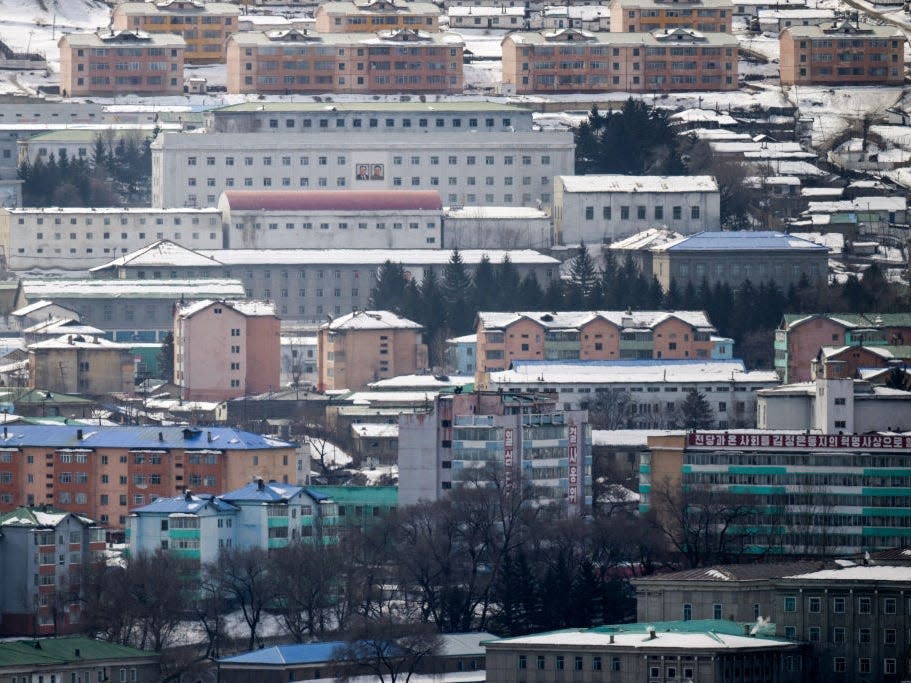
A wagon in the North Korean city of Namyang.
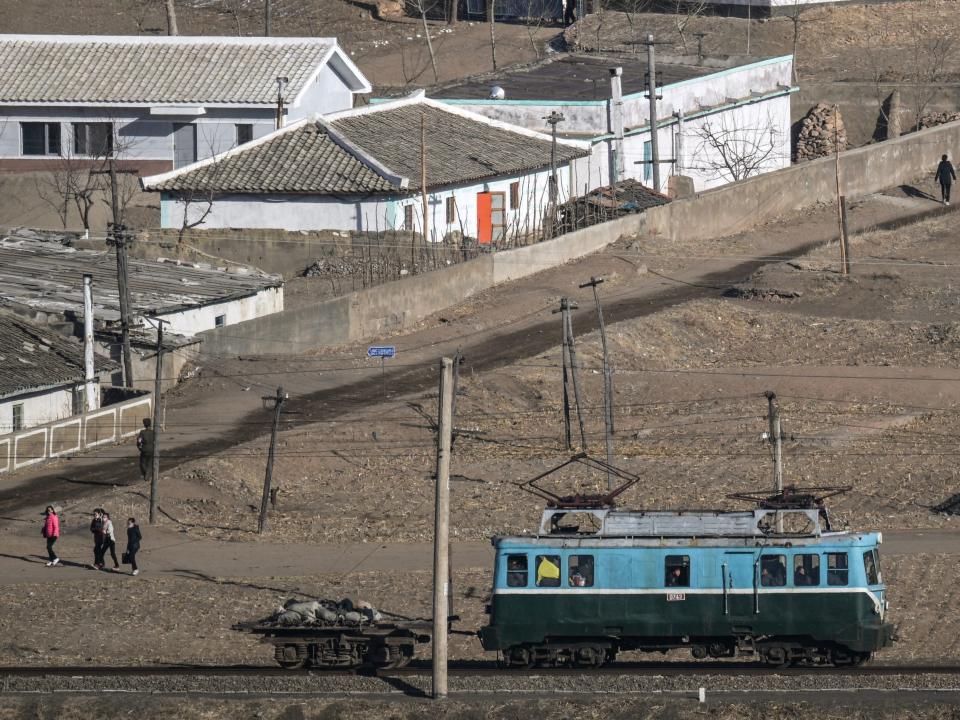
A sign on a hillside in the town of Chunggang reads: “My country is the best.”

A watchtower by the border in Hyesan.
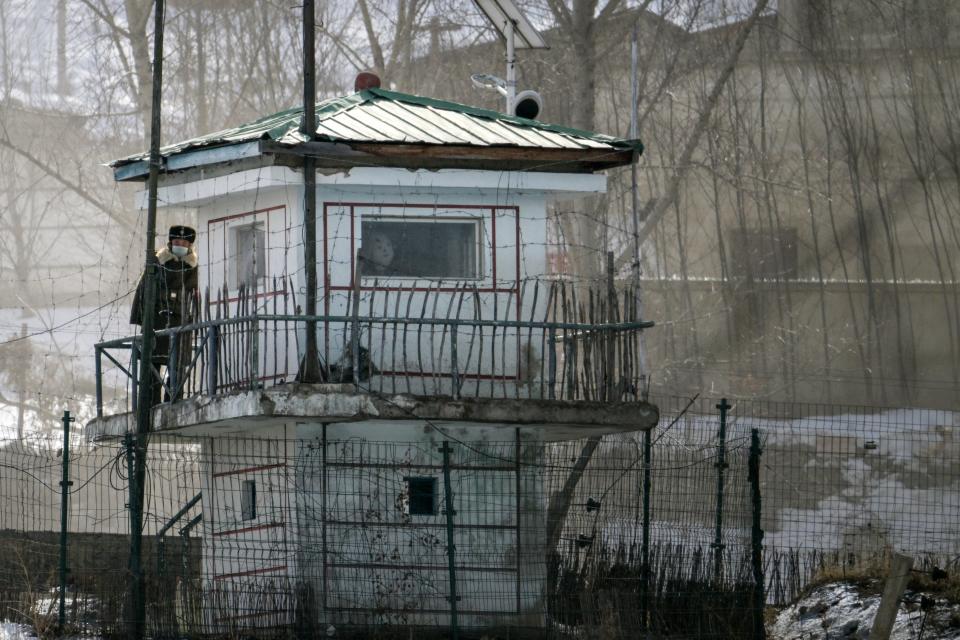
Portraits of former North Korean leaders Kim Il sung and Kim Jong Il in Chunggang.
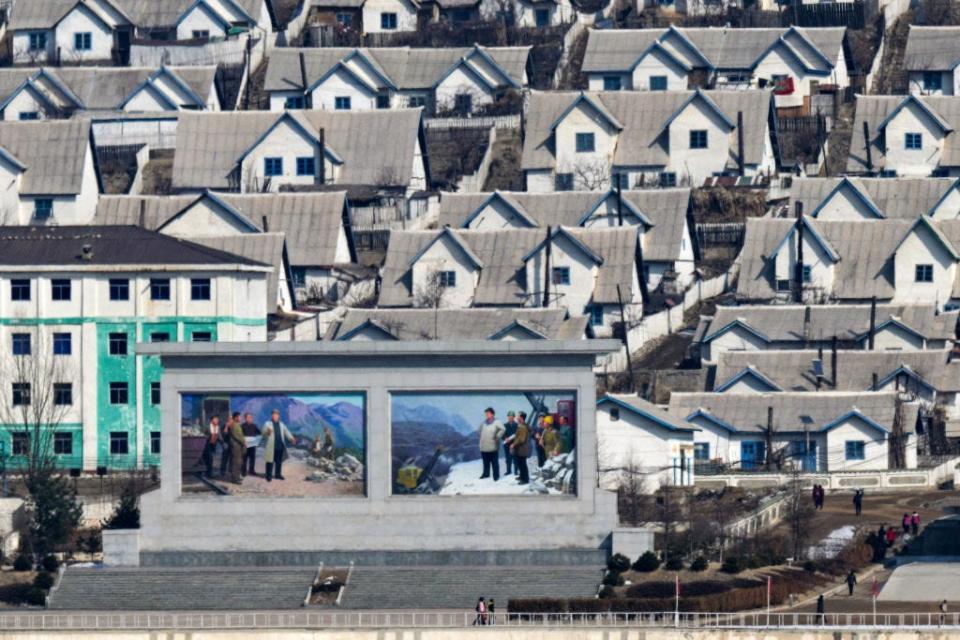
Another set of portraits of the former leaders on a government building in Namyang.
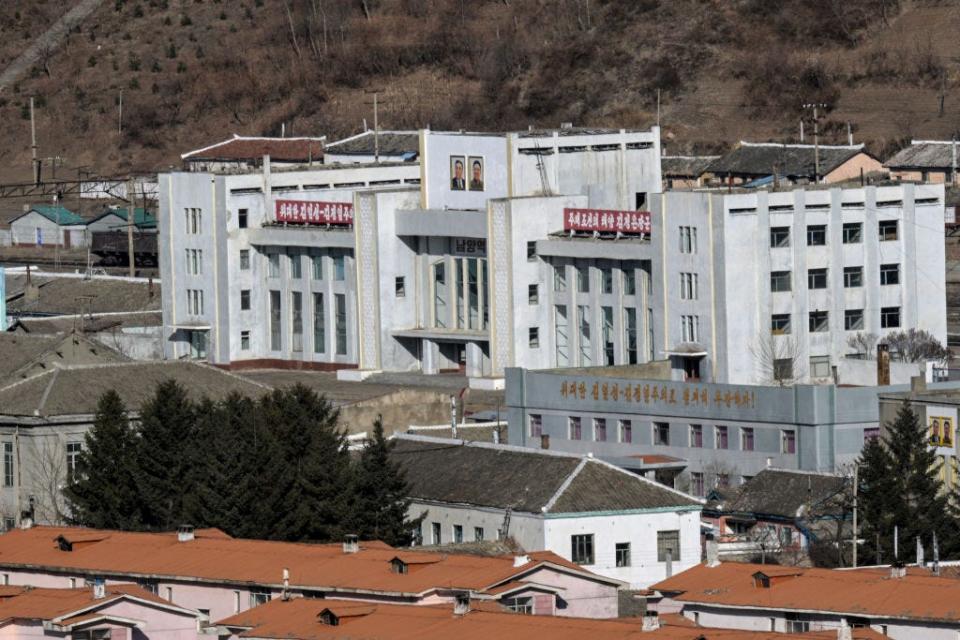
North Korean people working in a field.
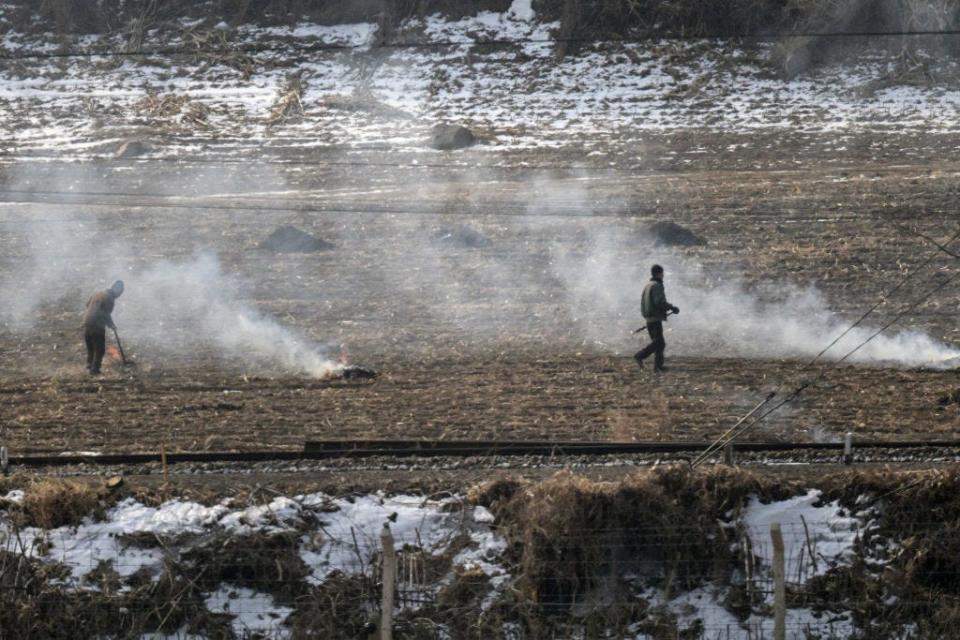
A sign in Chunggang reading: “Let’s unify the party and all society with the revolutionary ideas of comrade Kim Jong Un!”

Trucks crossing a border bridge connecting Changbai, China, and Hyesan, North Korea.
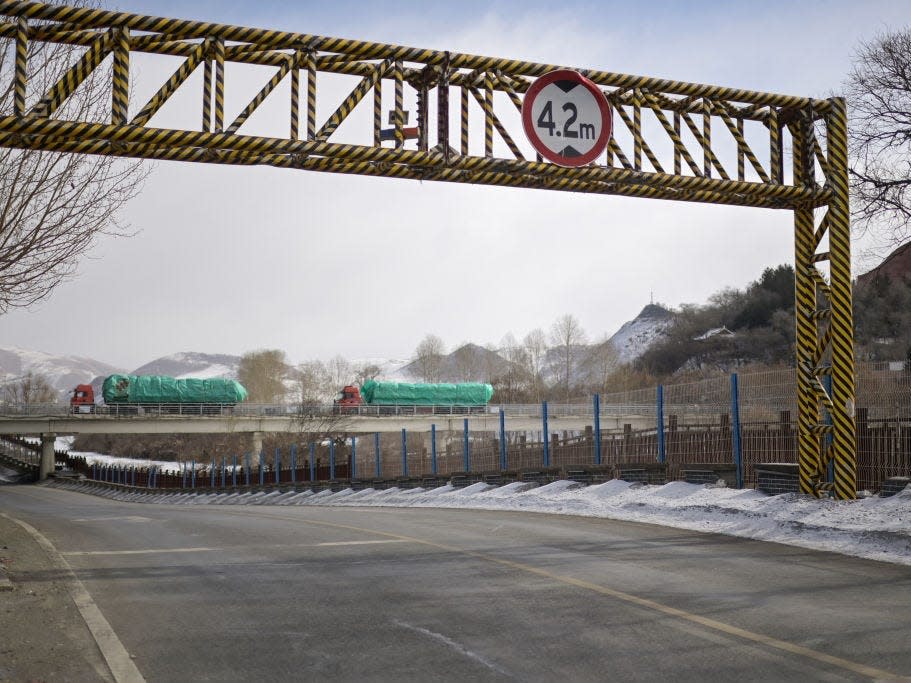
Read the original article on Business Insider
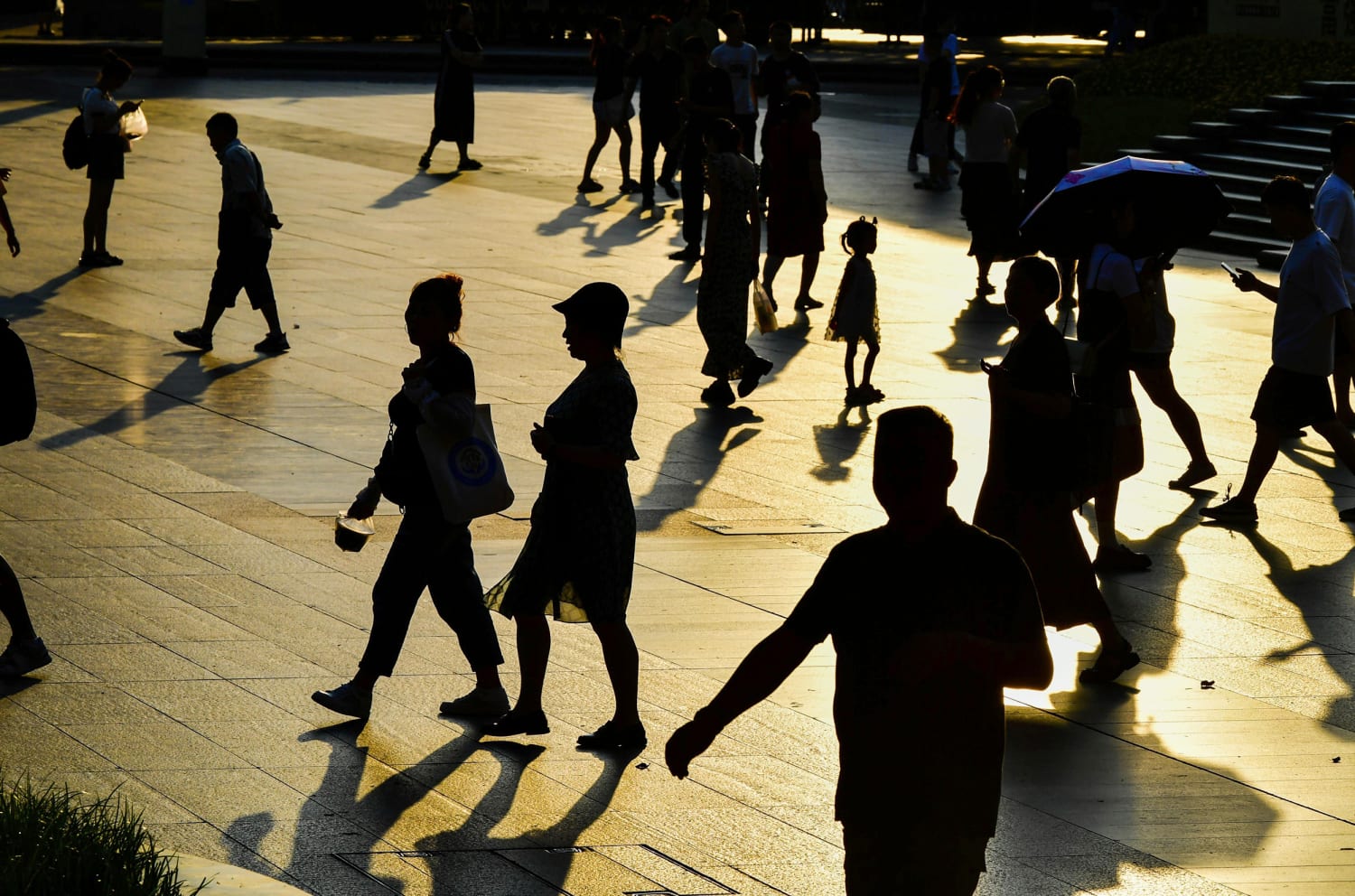
New research challenges the common idea that people need to reach a threshold of 10,000 steps per day to improve their health.
Walking just 4,000 steps per day is associated with a lower risk of death, according to the analysis published Tuesday in the European Journal of Preventive Cardiology.
The research pooled the results of 17 studies that looked at the health benefits associated with step counts across six countries. The least active people in the studies took around 4,000 steps per day and still saw a reduced risk of death from any cause. The more steps people took, the lower their risk of dying.
Each extra 1,000 steps per day was associated with a 15% reduction in a person’s overall risk of death, according to the research.
The analysis included people who took as many as 20,000 steps per day and did not find an upper limit to the health benefits of walking. Younger adults saw a greater reduction in the overall risk of death compared to older adults, the results showed.
“The main message is that we should have as many steps as possible and we should start as early as possible in order to have the highest health benefits,” said Dr. Maciej Banach, the study’s lead author and a cardiology professor at the Medical University of Lodz in Poland.
The studies that his team analyzed included almost 227,000 participants in total, most of whom were generally healthy, and followed people for an average of seven years. The participants came from Australia, Japan, Norway, Spain, the United Kingdom and the United States.
When looking at the risk of dying from cardiovascular disease in particular, the researchers found that walking at least 2,337 steps per day lowered the risk, with each extra 500 daily steps associated with an additional 7% reduction in risk.
The study suggested that for people under age 60, walking between 7,000 and 13,000 steps per day lowered the overall risk of death by 49%. For those ages 60 and older, walking 6,000 to 10,000 daily steps lowered the risk by 42%.
The notion that 10,000 steps is the crucial daily quota is a misconception, though it is a healthy target, according to Amanda Paluch, an epidemiologist and kinesiologist at the University of Massachusetts Amherst.
“It’s not an all-or-nothing situation,” she said.
The recommendation likely originated from a 1965 Japanese marketing campaign for a pedometer called “Manpo-kei,” which translates to “10,000 steps meter.”
There’s a reason it caught on, Paluch said: “It’s a nice, clean number. It is doable for a portion of the population, so it really stuck, but it has not been based on scientific evidence.”
For people who are minimally active, she added, 5,000 daily steps could be a good goal. The average person in the U.S. takes 4,774 steps per day, according to a 2017 study.
Paluch’s own research, which was included in the new analysis, found that people who walked a median of around 6,000 to 11,000 daily steps had a 50% to 60% lower risk of death, relative to those with a median of around 3,500 steps.
Plenty of past research has similarly shown that walking improves heart health and reduces the risk of cancer, diabetes and dementia.
The Department of Health and Human Services recommends that people get 150 to 300 minutes per week of moderate physical activity like riding a bike, 75 to 150 minutes per week of vigorous physical activity like jogging or running, or some combination. The guidelines also suggest doing muscle-strengthening activities at least two days a week.
A good rule of thumb is to be active enough that your heart rate is at least slightly elevated — meaning you can talk, but you can’t sing. A brisk walk or uphill hike meets that criteria, though Paluch said daily steps are usually considered light physical activity, so they wouldn’t count toward the federal guidelines.
“To really optimize your health in terms of being physically active you should incorporate both aerobic and resistance training,” she said.
While Texas Gov. Greg Abbott places buoys in the Rio Grande to make it harder for migrants to cross into his state, a growing number of migrants have braved record-breaking heat and dangerous terrain to cross into Arizona.
Long considered the most dangerous area to cross the U.S.-Mexico border, the Tucson sector is now also its busiest. On average, more than 1,300 migrants cross daily despite temperatures that regularly top 100 degrees, according to Customs and Border Protection data obtained by NBC News.
“This is a very rough, rough entrance into the United States,” said Jim Chilton, a rancher in Arivaca, Arizona, who regularly sees migrants cross his 50,000 acres of land.
“It’s gotten worse,” he said, noting a seemingly undeterred migrant population traversing his ranch.
Most of the migrants trying to cross Chilton’s property are single adult men trying to evade detection by Border Patrol. But in other areas, like around Nogales, families with young children are turning themselves in to agents to seek asylum.
NBC News recently traveled with Border Patrol agents in Nogales as they apprehended a group of 20 women and children who had crossed the border early in the morning, when the air was still cool.

One mother traveling with her 16-year-old son said they had been sleeping in the mountains and decided to turn themselves in to U.S. Border Patrol because they were exhausted and had nothing to eat.
The increase in families is especially concerning to Border Patrol agents and rescue workers, given this summer’s temperatures.
Agent Ronaldo Rios, the acting director of the Arizona Air Coordination Center, told NBC News he has seen groups crossing with more than 200 women and children, including babies and toddlers.
“The common hazard that folks are hearing about is going to be the heat,” said Rios. “Exposure to the elements — being out in our terrain or mountainous terrain for long periods of time — without any water.”
John Russell, a Border Patrol agent who flies Black Hawk helicopters for Customs and Border Protection’s Air and Marine operations, said that his unit recently received 26 calls for help in a single day. Many migrants who were trying to cross the border in remote terrain called for help during the first storm of southern Arizona’s annual monsoon season.
Calls to 911 “started rolling in,” said Russell. “There were three that we weren’t able to get to due to weather, aircraft availability. One of those was later found deceased. He didn’t make it. He succumbed to the weather.”
Department of Homeland Security officials are worried about the overall rise in families crossing the border as well. In Tucson, in particular, the rise in families could mean more migrant deaths.
“We are seeing very little kids that need water,” said Alejandro Avirde, a border patrol agent. “They’ve been doing this hike for five hours, and they’re in need of water.”
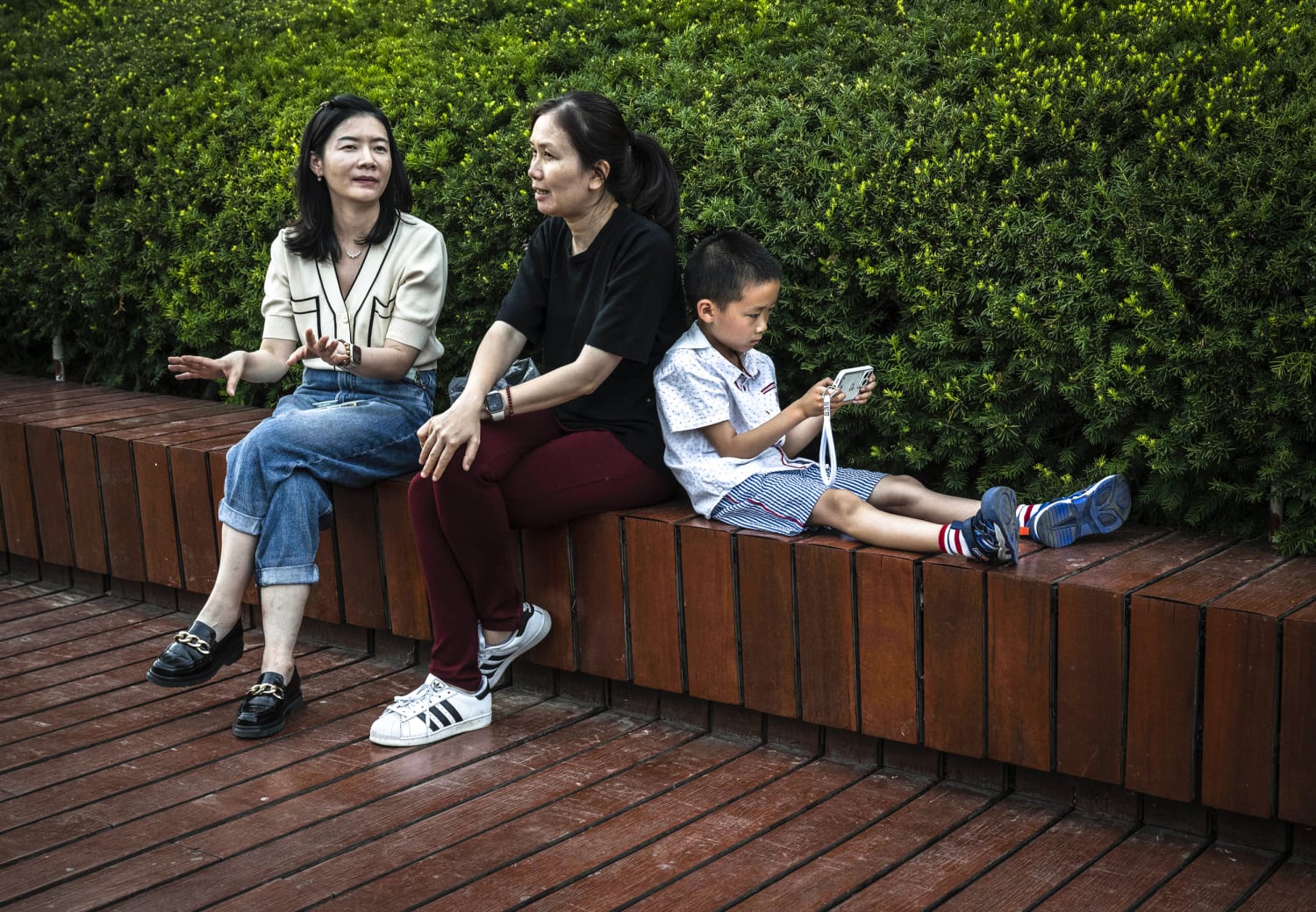
Chinese regulators have proposed rules that would limit the smartphone screen time of people under the age of 18 to a maximum of two hours per day.
The radical draft rules laid out by the increasingly powerful Cyberspace Administration of China (CAC) highlight Beijing’s desire to exert control over more parts of the country’s digital life.
If the rules are brought into law, they could have implications for companies such as Tencent and ByteDance, which run some of China’s biggest mobile apps.
The CAC’s draft rules are a broader push by Chinese authorities to curb and prevent addiction among those under 18 to apps and smartphones. In 2021, China introduced regulation that restricted teens under 18 years of age from playing online video games for more than three hours per week.
Some of China’s biggest internet giants have looked to pre-empt regulators’ further tightening measures.
The drafted rules require smartphones to have a “minor mode” for those under 18 years of age that should be easy to access when the device powers on, as either a home screen icon or in the system settings of the device.
The minor mode will allow parents to manage what their kids see and allow internet service providers to show content based on a user’s age. According to CAC, children under the age of three should be shown songs and audio-focused content. Those between 12 and 16 years of age can be exposed to educational and news content.
The CAC warned online firms not to provide services that induce addiction or are detrimental to the physical and mental healthy of kids.
The CAC’s draft rules split children into different age brackets and ascribe different restrictions depending on how old they are.
Children under the age of eight should be restricted to a maximum of 40 minutes a day on their smartphone. Kids aged over the age of eight but under that of 16 can use their phone for no more than one hour per day. Those aged between 16 and 17 can use a handset for a maximum of two hours.
A handset should not provide any services to children from 10 p.m. to 6 a.m. of the next day, according to the draft regulations.
There are some exemptions from these timings, as regulated education products or emergency services applications are not restricted.
A parent must verify attempts to take a device out of minor mode.
China’s rules have not yet been passed and are open to public consultation.
There are still question marks over how the draft law would be implemented and enforced, and what impact this might have on China’s technology giants.
For example, it is unclear if the creation of a minor mode will be the responsibility of the operating system provider of the device maker. In either case, it could put the onus on Apple, for example, to create something new for its iPhones in China.
It’s also to be determined how these time limits and the minor mode software will be monitored by the CAC.
Technology giants operating in the China — such as device makers like Apple and Xiaomi, as well as software players like Tencent and Baidu — will be watching the legislation closely.
When China cracked down on the gaming time of young people two years ago, Tencent and NetEase, two of the biggest online gaming companies in the world, said that users under the age of 18 contributed a tiny portion of their overall revenue.
California Congressman Eric Swalwell estimates that he receives “multiple death threats every single day” and that his chief of staff devotes up to 10 hours each week dealing with federal authorities sorting out the severity of threats faced by Swalwell, his family and staff members.
“My kids don’t play in our front yard because we get letters to the residence that are also threats,” he told CBS News on “The Takeout” this week. “People have shown when they call and say, ‘I know where you live’ and then you get a letter at the house, it shows they probably do.”
Swalwell, a Democrat, said the threats have forced him to change his habits and his office’s approach to security.
“My chief of staff estimates she spends eight to 10 hours a week dealing with the FBI, the Capitol Police and prosecutors around the threats,” Swalwell said. “We’ve spent hundreds of thousands of dollars from the campaign side for security.”
“Elected officials, we’re on the move,” Swalwell said. “We’re constantly in transit, but my staff, my family, they’re stationary, they’re fixed. And that’s what you worry about.”
As an example, Swalwell said his congressional staff was “harassed and terrorized” this week after a group he identified as Libs of TikTok accused him of supporting someone the group described as a pedophile in New Hampshire.
“They stormed my office,” Swalwell said. “I was voting, but they harassed and terrorized my staff.”
Capitol Police Chief Tom Manger told Congress that threats against members are up 300% over the last seven years.
Swalwell says the harsh atmosphere won’t change his approach to politics.
“We’re not going to be intimidated,” Swalwell said. “We’re not going to change anything about what I say or how I speak out.”
He says he has no real relationship with House Speaker Kevin McCarthy, and Swalwell blames the California Republican for helping to degrade his personal security and safety.
“It’s nonexistent,” Swalwell said. “He has targeted me and (fellow California Democratic Congressman) Adam Schiff ever since the Russian investigation. Not only attempted to vilify me but smeared me and Adam Schiff in ways that have changed our lives completely with the security threats.”
The most memorable moment of Swalwell’s largely forgettable 2020 presidential campaign may have been a broadside he leveled at then-candidate Joe Biden in a Democratic debate.
He urged Mr. Biden to “pass the torch” to a younger generation, echoing language then-candidate Biden had used when he first ran for president in 1987 – when Swalwell, now 42, was six years old.
“I was completely wrong,” Swalwell says now. “He’s proved all of us wrong. He proved me wrong.”
Swalwell said Mr. Biden approached him during the next commercial break at the June 2019 debate. “He said: ‘That was a pretty good one, wise ass,'” Swalwell said. “You know, he he’s been in the business for a long time. But he has proven us wrong with his energy, his ability, (with) what he’s accomplished.”
And he said he has no doubt Mr. Biden will be the Democratic nominee in 2024.
“He has achievements to run on,” Swalwell said. “He’s got a comeback story.”
Swalwell, like many Democrats was cautious in responding to a plea deal for Hunter Biden that fell apart Wednesday when it was presented to a federal judge for approval.
“Doesn’t happen often,” said Swalwell, a former state prosecutor in California. “This is why you play the game. Right? You can talk about what it’s supposed to look like, but in court, there there’s a very formulaic prose that the judge will follow and will make sure the defendant understands each part of it. It seems like the judge was not comfortable that both sides agreed on what the terms were.”
Swalwell rejected repeated Republican assertions that Hunter Biden’s business dealings could implicate the president in crimes.
“Look, they can knock themselves out,” Swalwell said. “You can say whatever you want….about Joe Biden, but I think it’s pretty hard to say that the guy’s corrupt.”
Swalwell scoffed at the GOP jibe “Biden Crime Family.”
“They also call him sleepy Joe,” Swalwell said. “Where I come from you can be sleepy or you can be corrupt, but I don’t know anyone who does both. There’s no there, there.”
Scott MacFarlane contributed reporting.
Executive producer: Arden Farhi
Producers: Jamie Benson, Jacob Rosen, Sara Cook and Eleanor Watson
CBSN Production: Eric Soussanin
Show email: TakeoutPodcast@cbsnews.com
Twitter: @TakeoutPodcast
Instagram: @TakeoutPodcast
Facebook: Facebook.com/TakeoutPodcast